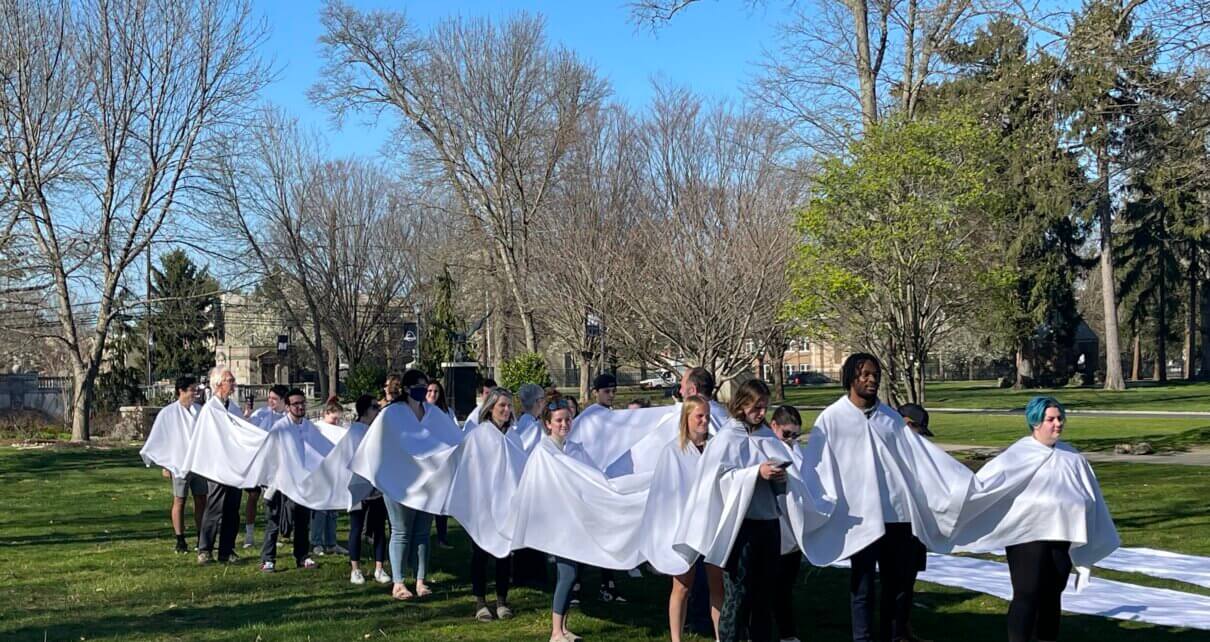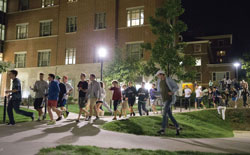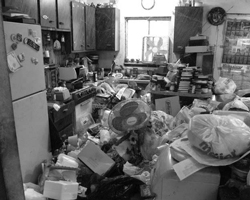Performed in the late 1960’s, Lygia Pape’s Divisor, or Divider, aimed to allow the viewer to interact with art in a new way. Divisor itself was meant to work as a multi-sensory art piece and create a direct relationship between the artwork and the viewer. Pape was able to transform the observer into the participant and create a work that brought individuals together. On April 12, Monmouth University students had their own re-performance of Divisor in an effort to reenact the piece in a present-day context.
While many have been invited to join in, the participants in the performance were students primarily from two courses: History of New and Expanded Media in Art taught by Corey Dzenko, Ph.D., Associate Professor of Art History, and Intercultural Communication taught by Deanna Shoemaker, Ph.D., Associate Professor of Communication and Performance Studies.
Divisor works as 75 yards of fabric with holes cut to allow participants to put their heads through a white large fabric piece and walk, skip, and move in celebratory ways. Dzenko, explained how Monmouth’s version of this performance evolved. She stated, “Our current context includes the ongoing COVID-19 pandemic and how Monmouth University has responded to it with safety protocols. We have been at such a distance from each other; this performance provides an opportunity to come together as a collective after our years of social distancing. When planning for the performance, we made sure to exceed the University’s suggestion of maintaining a distance of at least three feet from each other when possible.”
According to Dzenko, in Pape’s context, when originally creating Divisor in the 1960s, the Brazilian Armed Forces, with support from the US government, held a coup d’état, and overthrew the democratically elected President, eventually disbanding the Congress. The military controlled the nation state until 1985, installing generals as presidents.
During this time there was a lot of censorship, even towards artists. Pape turned to performance art creating a piece that, as some scholars remarked, would allow people to move in large groups through public areas even in times when protests were not encouraged and public spaces were surveilled.
Looking at what students have been through in the last two years of the pandemic, this piece was performed in a celebratory sense. Many students have struggled with being socially isolated, taking classes online, and having fewer personal interactions, overall. With everyone finally being back on campus, the context of Monmouth’s performance of Divisor is special in that it represents what we had lost and gained back since having to shift everything to suit the pandemic and the health needs of our community.
Dzenko mentioned that the idea of performing Divisor had been brought up to her in the past. This is the first semester she has taught this course since fall 2019 and the timing seemed just right.
“If we had performed it years ago, we likely would have thought very differently about the act of joining together, given the current context of both the pandemic and the further partisan divides in our country currently. This performance gave students the opportunity to not just read or talk about, but to live this type of experience.”
Students have been working on this performance for the last few weeks. Gianna Veritas, President of the Art Club and a student in Dzenko’s class, noted, “Participating in the event has allowed me to be very involved, which was a goal of mine when becoming President of the Art Club. We worked for a few long hours measuring and cutting out the large fabric piece. At some point I was even out of breath!”
Veritas added, “I hope to encourage more students to join future events as well. I also want to give big thank you to Dr. Dzenko for reaching out to me and giving me the opportunity to help out. It was a great performance!”
Overall, Monmouth’s re-performance of Lygia Pape’s Divisor has a deeper meaning. Though it might look like a bunch of people walking under a sheet, it’s a mark of our community and us finally coming back together. It marks the end of the academic year that was filled with much struggle dealing with precautions taken due to the pandemic. In Monmouth’s context, this event brought people together, from different majors and different backgrounds. With hopes to perform it again in the future with ever-changing contexts, this re-performance of Divisor hopefully marks something big for students at Monmouth.




